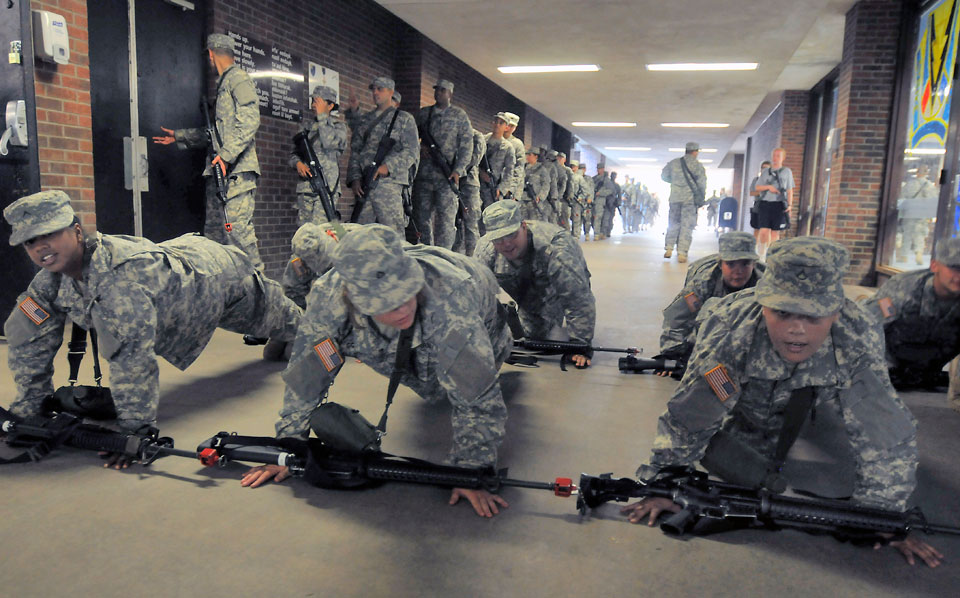
Congress has once again deferred making a decision as to whether to finally end draft registration or to expand it to include young women as well as young men.
The final version of this year’s annual National Defense [sic] Authorization Act (NDAA) approved by Congress on December 14th and signed into law on December 27th by President Biden makes no change to the provisions of the Military Selective Service Act (MSSA) which authorize the president to order men, but not women, to register with the Selective Service System (SSS) for a possible military draft. This leaves the current Selective Service registration and address reporting requirements (applicable to young men but not women) in effect, and the issue unresolved.
Earlier this year, both the House and Senate Armed Services Committees voted, without debate or hearings on Selective Service, to recommend that the Fiscal Year 2022 NDAA include a section that would have expanded draft registration to women. A version of the NDAA including this provision was approved by the full House of Representatives (without a floor vote on any of the proposed amendments related to Selective Service), and was on the verge of approval in the Senate.
However, in the face of a deadlock in the Senate over this and other provisions of the NDAA, House and Senate leaders worked out a back-room package of compromises that included removing the section of the FY 2022 NDAA that would have expanded draft registration to women.
The only provisions related to Selective Service that remain in the final version of the NDAA order more studies and reports to Congress by the Department of Defense about Selective Service and mobilization options. This tends to confirm that Congress has merely punted, not abandoned the question, and expects to revisit it.
Democrats may hope to bring the future of Selective Service up again in 2022, while they still narrowly control the House and Senate. Republicans may prefer to put it off until 2023 when they expect to have regained control of Congress. Both Rep. Jackie Speier, D-Calif., Chair of the Military Personnel Subcommittee of the House Armed Services Committee and a leading proponent of expanding Selective Service to women, and Rep. Peter DeFazio, D-Ore., the leading sponsor in the House of the Selective Service Repeal Act, have announced that they don’t plan to run for reelection in 2022, which may influence whether this is considered before or after the 2022 elections. But the issue won’t go away.
Where does this leave draft registration and contingency planning for a draft?
A proclamation by President Jimmy Carter, issued in 1980, requires men to register with the SSS within 30 days of their 18th birthday, and report to the SSS, within 10 days, every time they change their address until their 26th birthday. Few young men fully or voluntarily comply, and enforcement was abandoned in failure decades ago, but this presidential order and the law authorizing it remain on the books. Congress and military planners continue to pretend that a draft based on the current incomplete and inaccurate Selective Service registration database remains a realistic “fallback” option for the Pentagon.
What’s on the table for Congress in 2022-2023?
There are three main options on the table, with a fourth as a wild card. Congress could decide to:
Maintain the status quo, requiring men but not women to register for the draft, at least unless and until another lawsuit works its way up to the Supreme Court, the Supreme Court chooses to hear it, and the Court rules that requiring men but not women to register is unconstitutional. This is the option preferred by many pro-war sexists, but some of them are wavering: Nakedly sexist legal obligations and criminal penalties are just too obviously discriminatory to defend forever.
Attempt to expand Selective Service registration and contingency planning for a draft to women as well as men. This seemed an obvious and relatively easy way out for many liberals and moderates, but support for this option also appears to be softening in the face of objections both practical (few men comply with the registration and address reporting requirements, and there is no plan for how to force unwilling women to comply) and political (members of Congress, including the “liberals” who have been leading the push to expand registration, don’t really want to be held accountable at the polls for making martyrs of young women who refuse to register for the draft, as will be necessary if any attempt is made to enforce an expanded registration requirement).
Repeal the MSSA entirely and end draft registration. This option is winning increasing and bipartisan support from those whose first choice is one of the options above, but who see this as the second-best alternative. Repealing the President’s authority to order anyone to register for a possible draft, and ending contingency planning for a (male-only) draft, is the only way to end the naked sexism of the current male-only draft registration requirement without threatening to “Draft Our Daughters” (and without having to try to enforce draft registration or its expansion to women as well as men).
Suspend draft registration and put the SSS into standby as it was from 1975-80. This is almost nobody’s first preference, but might be put forward as a compromise. There’s a complication, though: If the SSS is to continue contingency planning for a draft, even on a “standby” basis, Congress will need to decide whether those plans and preparations should be for a draft of men only or of both men and women. So the repeal of the MSSA (the third option above) may actually be the most widely acceptable compromise.
Congress doesn’t make multiple-choice decisions by ranked-choice voting, so the outcome may depend on how the questions are presented.
How will Congress handle this issue in 2022-23?
In response to the Congressional leadership compromise over this year’s NDAA, which punts this decision into 2022 or 2023, there has been talk from all sides of the possibility of hearings and consideration of legislation on Selective Service through standalone bills rather than as part of the NDAA. Standalone bills either to repeal the Military Selective Service Act or expand it to women are already pending in Congress, although none of them have received a hearing.
Following enactment of the NDAA, Sen. Kirsten Gillibrand (D-N.Y.), one of the leading advocates on the Senate Armed Service Committee for expanding draft registration to women, told NPR that she’ll “continue to pursue ‘all legislative routes to implement this policy’ through annual defense spending or a standalone bill.”
That same day, Elaine Donnelly of the pro-military Center for Military Readiness, an outspoken opponent of expanding draft registration to women, wrote that “Next time, any proposal regarding Selective Service should be debated in the open, after full hearings with independent witnesses, in a stand-alone bill in regular order.”
These are positive developments for opponents of the draft and draft registration. Hearings on standalone bills make repeal of Selective Service more likely than consideration of the issue as part of the massive multi-issue NDAA without separate hearings on Selective Service.
A coalition of anti-war and anti-draft activists has already called on Congress “to give this issue the full consideration it warrants, by holding a full and fair hearing on this issue that considers both policy options before Congress—either ending Selective Service registration or expanding it to women—and that hears from witnesses in support of each of those options.”
Consideration of standalone legislation on Selective Service, rather than bundling this issue into a future year’s NDAA, would allow for more thorough debate. It would also force members of Congress to go on record, for the first time in years, with a separate roll-call vote on this issue. Some members of both the House and the Senate voted against the entire 2,000+ page NDAA, but none of those votes could be attributed specifically to what the bill did or didn’t say about Selective Service. Most members of Congress have yet to take any public position with respect to Selective Service—and don’t want to, fearing that whatever they do will anger some of their constituents. That fear is, to some degree, well founded. But support for a draft is quite weak, and ending draft registration entirely (“Door Number 3”) may be the position that will prompt the least backlash from voters.
Hearings are also likely to shift the debate in favor of ending draft registration, as long as independent witnesses supporting both repeal and expansion of Selective Service are invited to testify. The Selective Service emperor has no clothes. When even the former Director of the Selective Service System has testified that noncompliance has made the Selective Service database so incomplete and inaccurate as to be “less than useless” for an actual draft, it should be clear that the Potemkin “mobilization capability” purportedly provided by draft registration will not withstand critical scrutiny. Any full and fair hearing will call attention to the possibility of repeal and further expose the failure of draft registration, the impossibility of enforcing it, and the pointlessness of continuing it, much less trying to expand it to women.
Meanwhile, in state legislatures
Such limited compliance with the registration requirement as the Selective Service System currently obtains depends almost entirely on state laws that link Selective Service registration to the issuance of drivers’ licenses. This is true for young men today, and will also be true for young women if the registration requirement is expanded. These state drivers’ license laws have become even more critical since the requirement to register with the SSS in order to be eligible for federal student aid was ended by Congress a year ago and that change took effect in August of this year.
The problem for the SSS is that (1) not all states have such laws (populous states with no such laws include California, Pennsylvania, New Jersey, Massachusetts, and Oregon), (2) in most of the states that do have such laws, they use gendered language that makes them apply only to men, and will be vulnerable to challenge, unless amended state by state to apply also to women, if federal law is changed to require women as well as men to register with the SSS, and (3) many of the same state legislators who were most willing to press their state motor vehicle codes to sign up young men for the draft may be least willing to use those same laws to force young women to sign up to be drafted, a problem that was anticipated by the National Commission on Military, National, and Public Service (NCMNPS) in closed-door discussions disclosed only long afterward in response to my Freedom of Information Act requests.
So the highest current priority for the SSS, consistent with the longstanding state lobbying program disclosed in response to another FOIA request, is to persuade state legislators (1) to enact such laws in states without them (a bill for this purpose, H. 4263 / S. 2585, is already pending in Massachusetts), and (2) to amend gendered state laws linking Selective Service registration to drivers’ licenses to use non-gendered language, so that they will remain valid if Selective Service registration is expanded to women.
This ongoing state-by-state legislative activity will continue in parallel with the ongoing Congressional debate over whether to end draft registration or try to expand it to women. These debates about the use of state laws to get young people to register for the draft are not a mere footnote to the Congressional debate about federal law: If states won’t use their drivers’ license laws to pressure young people to register, the federal government—which abandoned enforcement of the criminal penalties for refusal to register with Selective Service decades ago—has no “plan B” for enforcement of registration. Monitoring and opposing proposals in their state legislatures for new or expanded linkages between drivers’ licenses and draft registration, and working to repeal existing state laws related to Selective Service to preempt any attempt to expand them, should be a priority this year for opponents of the draft and draft registration.
What else can opponents of the draft, registration, and the unpopular wars they enable do?
Don’t wait. The time to organize against the draft and draft registration is now.
Consciousness raising is the first step. Spread the word to everyone you know, especially young women. Most people have no idea that there is ongoing planning and preparation for military conscription in the U.S., that ten thousand members of draft boards covering every county in the U.S. have been appointed and trained to administer a future draft, that applicants for learners’ permits or drivers’ licenses as young as 15 years old in some states are being signed up to kill or be killed on command (notwithstanding U.S. government crocodile tears about the conscription of “child soldiers” in other countries), or that Congress is on the verge of a decision as to whether to end all of this or to try to expand it to young women.
Urge your state legislators to repeal, not expand, state laws linking Selective Service registration to drivers’ licenses. Urge your U.S. Representative and U.S. Senators to (1) cosponsor the Selective Service Repeal Act (H.R. 2509 / S. 1139) and (2) push for full and fair hearings on this bill, with independent nongovernmental witnesses, in the House and Senate Armed Services Committees. It’s especially critical to get members of both Armed Services Committees to support this bill and the call for a full hearing on it, which no member of either Armed Service Committee has yet done. There’s a phone script and an e-mail form you can use to contact Congress. Or you can send your own message.
Put Representatives and Senators on the spot by asking questions at town halls and other events: Do they believe that young women (or young men) who refuse to agree to fight any future war that not enough people are willing to volunteer to fight should be put in prison? If not, why aren’t they a cosponsor of, and calling for a hearing on, the Selective Service Repeal Act? Don’t let them off with a facile answer of “Because equality.” As opponents of draft registration said in a joint letter to Congress earlier this year, “Expanding draft registration to women would bring about a semblance of equality in war (although women in the military would likely still be subject to disproportionate sexual harassment and abuse). Ending draft registration would bring about real equality in peace and freedom.”
Let members of Congress know that you support young men who refuse to register for the draft and young women who will do likewise and that your opposition will be obstructive, not just noisy.
Draftees and their families, friends, and lovers are expected to complain about the draft. Members of Congress don’t care if people complain to Congress or “protest” the draft, as long as young people submit. See, for example, this excerpt from the SSS readiness plan with guidance to public affairs staff on “disruptive events” (which includes recruiting ROTC professors to spy on anti-draft activists on local campuses).
But in deciding whether they can get away with expanding draft registration to women, members of Congress will be influenced, perhaps decisively, by indications of the likely scale of noncompliance by young people, and of support for it by older allies. The fact that most noncompliance with draft registration is closeted and invisible makes it easy to ignore. There’s a symbiosis between closeted spontaneous mass noncompliance and smaller numbers of public resisters.
For the inevitability of widespread noncompliance—and of an embarrassing (for the government) fiasco of ineffective show trials in a futile attempt at selective enforcement as an intimidation tactic—to be recognized and taken into consideration by Congress, some young women will have to come out about their refusal to register, or their intention to resist if ordered to register, as I and some other young men did in the 1980s before the government abandoned enforcement of the law requiring registration.
The most effective way to influence Congress may be for young people to speak out publicly about their intention not to register voluntarily for the draft. Even if you don’t make a public commitment to illegal resistance, you can make clear that you won’t go voluntarily or without a fight in court and in the court of public opinion. Young women who don’t want to fight for Trumpian fascism or against whomever the present or a future Commander-in-Chief proclaims to be an enemy will make sympathetic defendants.
Make the government work if it wants to draft you. Don’t sign for any letters or talk to the SSS or FBI. Anything you say can and will be used against you. Don’t register with the SSS unless and until you have to do so for some other government program, the FBI tracks you down and personally serves you with provable notice to register, or you are approaching your 26th birthday and almost out of draft age. If you are registered, don’t acknowledge or respond to an order to report unless and until the FBI tracks you down and personally serves you with provable notice of an induction order. The government has to prove your actual knowledge of any SSS requirement in order to prosecute you for violating it.
Older allies can provide counseling resources and advice to help young people understand the Selective Service maze and inform their choices. More importantly, older allies can help make young people aware of the potential power of draft registration resistance as direct action by young people that can help remove the draft from the arsenal of war planning and protect us all against larger, longer, less popular wars. As older allies, we can provide solidarity and support to young people in their resistance, and amplify their voices.










